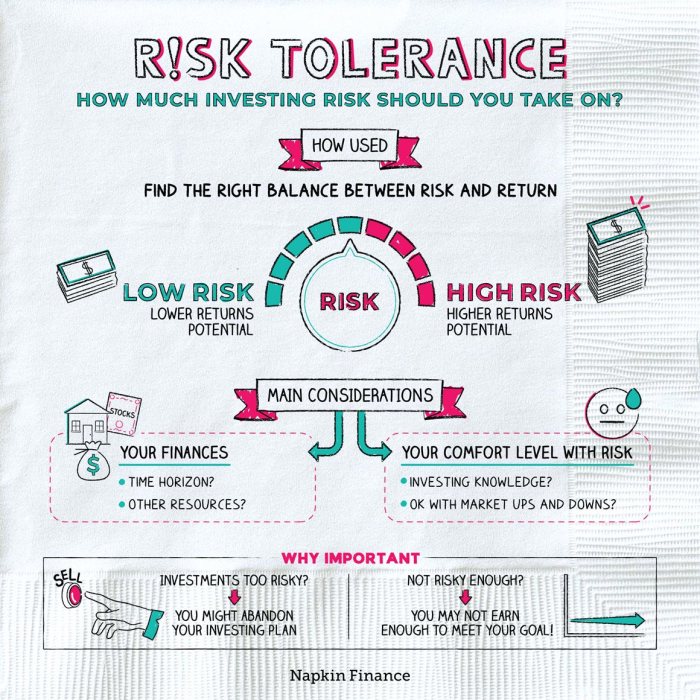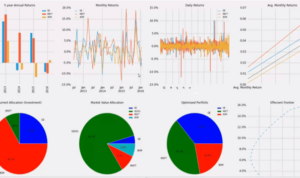Step into the world of financial risk tolerance where decisions can make or break fortunes. Get ready for a rollercoaster ride of understanding how different individuals navigate the risky waters of investments based on their unique characteristics and goals.
Let’s dive deeper into the nuances of risk tolerance and explore the factors that shape our financial decision-making process.
Understanding Financial Risk Tolerance
Financial risk tolerance refers to an individual’s ability to handle fluctuations in the value of their investments. It plays a crucial role in making informed investment decisions that align with one’s financial goals and comfort level with risk.
Factors such as age, income, financial goals, and personal circumstances all influence an individual’s risk tolerance. Younger individuals with a longer investment horizon may have a higher risk tolerance as they have more time to recover from any potential losses. On the other hand, older individuals nearing retirement may have a lower risk tolerance to preserve their savings.
Impact of Risk Tolerance
- High risk tolerance: Investors with high risk tolerance are willing to take on more risk in exchange for potentially higher returns. They may focus on aggressive growth strategies such as investing in volatile assets like stocks.
- Low risk tolerance: Investors with low risk tolerance prefer more stable investments with lower volatility, such as bonds or savings accounts. They prioritize protecting their capital over seeking high returns.
- Moderate risk tolerance: Those with moderate risk tolerance seek a balance between risk and return. They may opt for a diversified portfolio that includes a mix of equities and fixed-income securities.
Assessing Risk Tolerance
Assessing risk tolerance is a crucial step in determining the most suitable investment strategy for an individual. By understanding how much risk an investor is comfortable with, financial advisors can tailor recommendations that align with their goals and preferences.
Methods of Assessing Risk Tolerance
- Risk Tolerance Questionnaires: These are commonly used tools that ask investors a series of questions to gauge their comfort level with various investment scenarios. Based on their responses, an investor’s risk profile can be determined.
- Surveys: Similar to questionnaires, surveys can also help assess risk tolerance by presenting different hypothetical situations and analyzing how investors would react to them.
- Psychometric Testing: Some financial advisors use psychometric testing to assess an individual’s risk tolerance based on their personality traits and behavioral patterns.
Role of Risk Tolerance Questionnaires and Surveys
- These tools provide a structured way to collect information about an investor’s risk preferences and financial goals.
- They help financial advisors understand how much volatility an investor can tolerate and what level of risk they are comfortable with.
- By analyzing the responses, advisors can categorize investors into different risk profiles, such as conservative, moderate, or aggressive, to make suitable investment recommendations.
Financial Advisors’ Use of Risk Tolerance Assessments
- Financial advisors use risk tolerance assessments to ensure that investment recommendations are in line with an individual’s risk appetite and financial objectives.
- By customizing investment strategies based on risk tolerance, advisors can help investors achieve a balance between risk and return that suits their preferences.
- These assessments also help advisors educate investors about the potential risks associated with different investment options and set realistic expectations about returns.
Factors Influencing Risk Tolerance

When it comes to risk tolerance, various factors come into play that can influence how individuals perceive and respond to financial risks.
External Factors
External factors such as market conditions and economic outlook can significantly impact an individual’s risk tolerance. For example, during times of economic uncertainty or market volatility, individuals may become more risk-averse and opt for safer investment options. On the other hand, a bullish market may lead to increased risk appetite among investors, prompting them to take on more risk in pursuit of higher returns.
Internal Factors
Internal factors, including personality traits and past investment experiences, also play a crucial role in determining risk tolerance. Some individuals naturally have a higher tolerance for risk, while others may be more risk-averse due to their personality characteristics. Additionally, past experiences with investments, whether positive or negative, can shape an individual’s perception of risk and influence their risk tolerance levels.
Life Circumstances
Changes in life circumstances, such as getting married, having children, or nearing retirement, can impact an individual’s risk tolerance over time. For instance, someone who is younger and just starting their career may have a higher risk tolerance compared to someone who is close to retirement and prioritizing capital preservation. As individuals progress through different life stages, their risk tolerance may evolve to align with their changing goals and responsibilities.
Managing Risk Tolerance
When it comes to managing risk tolerance in financial planning, it is crucial to align investment decisions with one’s risk tolerance level. This involves understanding your comfort level with taking risks and ensuring that your investment strategy reflects this.
Risk Capacity and Its Role
Risk capacity complements risk tolerance by considering your financial situation, goals, and time horizon. It looks at how much risk you can afford to take based on your current financial position. For example, a young investor with a stable income and a long time horizon may have a higher risk capacity compared to someone nearing retirement.
- By understanding your risk capacity, you can make informed decisions that align with your financial goals and constraints.
- It is essential to balance risk tolerance and risk capacity to create a well-rounded investment strategy.
Diversification and Asset Allocation for Risk Management
Diversification involves spreading your investments across different asset classes to reduce the impact of market volatility on your portfolio. Asset allocation, on the other hand, focuses on distributing your investments among various asset classes based on your risk tolerance and financial goals.
- Diversification helps mitigate risk by not putting all your eggs in one basket, reducing the impact of market fluctuations on your overall portfolio.
- Asset allocation ensures that your investments are aligned with your risk tolerance, helping you achieve a balanced and diversified portfolio.






